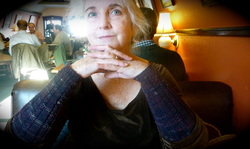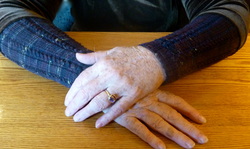

 Here I am sitting at Bintliff's which is, according to my son Blake and me, the very best breakfast place in Portland. My arms are adorned with Stulpin, which are European knitting garb intended for either your forearms or your legs. We had two guests from Germany staying over in our Airbnb room and I was knitting knee socks as we chatted over the breakfast scones in the studio. One of the ladies wondered if I could make the socks without feet. It took us a while to figure each other out, what with her not so good English and my much, much worse German, but we managed. The results are these Stulpin, which are now with her in Munich keeping her forearms, or her legs, warm through the cold European winter.  This is a closer view of them showing the little mock cables that I put on my particular version. I will post a pattern on Ravelry and on my Etsy site if you want to make them exactly like mine but if you are a sock knitter almost any rib like pattern that you would use on socks will work nicely. Color work might not be stretchy enough for arms and legs, particularly if you have working class calves like mine.
1 Comment
=Tamar
12/15/2011 01:20:23 pm
How interesting that the German word for them is stulpin. Someone once asked that I prove they ever were worn, so I collect references. The British term for arm-warmers was scoggers (hoggers were for legs) (Rutt, A History of Knitting, 1988). The Bavarians called them Narukvitsi (forearm-warmers) and kaltsi ("a kind of gaiters") (Bulgarian National Costumes and Folk Jewellery, 1983). The Spanish in the 16th century probably just called them sleeves, even when they sewed jewels onto them (Hispanic Costume, 1979).
Reply
Leave a Reply. |
About Martha
Archives
February 2019
Categories |